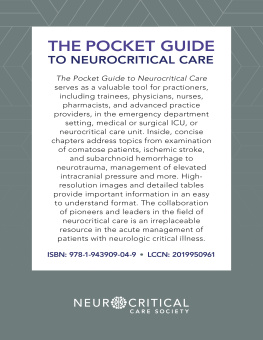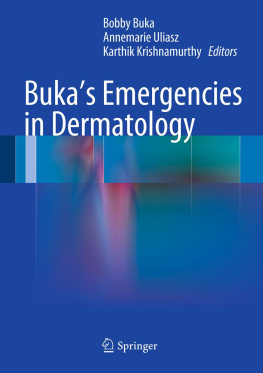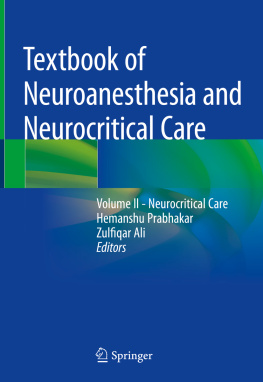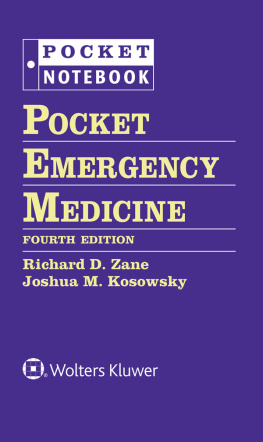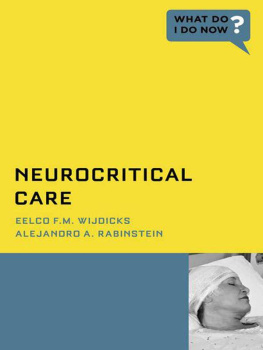Marin Darsie - The Pocket Guide to Neurocritical Care
Here you can read online Marin Darsie - The Pocket Guide to Neurocritical Care full text of the book (entire story) in english for free. Download pdf and epub, get meaning, cover and reviews about this ebook. year: 2019, publisher: Neurocritical Care Society, genre: Science. Description of the work, (preface) as well as reviews are available. Best literature library LitArk.com created for fans of good reading and offers a wide selection of genres:
Romance novel
Science fiction
Adventure
Detective
Science
History
Home and family
Prose
Art
Politics
Computer
Non-fiction
Religion
Business
Children
Humor
Choose a favorite category and find really read worthwhile books. Enjoy immersion in the world of imagination, feel the emotions of the characters or learn something new for yourself, make an fascinating discovery.
- Book:The Pocket Guide to Neurocritical Care
- Author:
- Publisher:Neurocritical Care Society
- Genre:
- Year:2019
- Rating:4 / 5
- Favourites:Add to favourites
- Your mark:
- 80
- 1
- 2
- 3
- 4
- 5
The Pocket Guide to Neurocritical Care: summary, description and annotation
We offer to read an annotation, description, summary or preface (depends on what the author of the book "The Pocket Guide to Neurocritical Care" wrote himself). If you haven't found the necessary information about the book — write in the comments, we will try to find it.
The Pocket Guide to Neurocritical Care — read online for free the complete book (whole text) full work
Below is the text of the book, divided by pages. System saving the place of the last page read, allows you to conveniently read the book "The Pocket Guide to Neurocritical Care" online for free, without having to search again every time where you left off. Put a bookmark, and you can go to the page where you finished reading at any time.
Font size:
Interval:
Bookmark:



Copyright 2019 by Neurocritical Care Society All rights reserved. No part of this publication may be reproduced, stored in a retrieval system, or transmitted in any form or by any means, electronic, mechanical, photocopying, recording, or otherwise, without the prior written permission of the author. Disclaimer: This content was developed by the Neurocritical Care Society (NCS) and is intended to be used as an educational tool and should not be construed as medical advice. The editors and authors have made every effort to present accurate and complete information at the time of publication, however new information on any of the topics contained in this book may emerge. The authors, editors, publisher, or any party involved in the production of this work cannot guarantee that all data presented herein is complete or accurate, and these parties are not responsible for any omissions or errors in this text or liable for outcomes due to use of this text. Note that this includes drug information.
The information in this text cannot replace independent evaluation by a qualified medical professional. Except when otherwise cited, the views expressed by the authors and editors are their own and are not necessarily the views of any institution with which the authors or editors are affiliated. Practitioners should refer to institutional policies and practices where appropriate. References have been provided by chapter authors at the end of each chapter. NCS respects the intellectual property rights of others and prohibits users from reproducing content that violates another partys intellectual property rights. If you believe that any material infringes upon any copyright which you own or control, you may send a written notification of such infringement to NCS.
ISBN-13: 978-1-943909-04-9 Library of Congress Control Number: 2019950961 Printed in the United States of America

We hope that this will be just the first of their many future publication opportunities. This book compiles chapters of the highest-yield information as suggested and recommended by providers and trainees across multiple disciplines who all have a common interest in caring for neurocritical care patients. It is not meant to be an exhaustive reference, but to give readers a strong fund of knowledge in neurocritical care to support their practice. vi ACKNOWLEDGEMENTS Special thanks go es to our editorial team: Anand Venkatraman, Justin Barr, Kassi Kronfeld, Megan Barra, and Pouya Ameli. We would like to recognize the members of the NCS Educational Products Committee for their oversight and support in developing this project, as well as their time spent editing and reviewing its content for accuracy. A special thank you to Angel Gindele who coordinated all the authors, timeline, and editorial needs of this edition.
Without her, this could not be the comprehensive and refined product before you. Finally, we would like to thank our families. We are the best versions of ourselves because of your love and support. Marin Darsie, Asma Moheet, and Winnie Lau October 2019 vii ABBREVIATIONS + positive decreased increased AAN American Academy of Neurology Ab antibody ABCs airway, breathing, circulation ABG arterial blood gas AC assist control ACA anterior cerebral artery ACh acetylcholine AChEI acetylcholinesterase inhibitor(s) AChR acetylcholinesterase receptor(s) ACEI angiotensin-converting enzyme inhibitor(s) ACLS Advanced Cardiac Life Support AComm anterior communicating artery ADR alpha delta ratio AED anti-epileptic drug AF atrial fibrillation AG anion gap AHA American Heart Association AICA anterior inferior cerebellar artery AIDS acquired immude deficiency syndrome AIS acute ischemic stroke ALS amyotrophic lateral sclerosis AKA also known as ARDS acute respiratory distress syndrome aSAH aneurysmal subarachnoid hemorrhage ASIA American Spinal Injury Association ASV adaptive support ventilation ATLS Advanced Trauma Life Support AVDO2 arterio-venous difference of oxygen consumption AVM arteriovenous malformation BAL dimercaprol BCx blood culture BBB blood-brain barrier BID twice daily BiPAP bi-level positive airway pressure BMP basic metabolic panel BP blood pressure BTF Brain Trauma Foundation BSAS Be dside Shivering Assessment Scale C Celsius Ca2+ calcium CAA cerebral amyloid angiopathy CABG coronary artery bypass graft CAS carotid artery stenting CBC complete blood count CBF cerebral blood flow CCM cereb ral cavernous malformation CEA carotid endarterectomy cEEG continuous EEG CHF congestive heart failure CI continuous infusion CIDP chronic inflammatory demyelinating polyneuropathy COPD chronic obstructive pulmonary disease CIM critical illness myopathy CIWA Clinical Institute withdrawal assessment CKD chronic kidney disease CMP comprehensive metabolic panel CMRO cerebral metabolic rate of oxygen CMV cytomegalovirus CN cranial nerve CNS central nervous system CO cardiac output viii CPAP continuous positive pressure ventilation CPP cerebral perfusion pressure CPR cardiopulmonary resuscitation CrCl creatinine clearance CSE convulsive status epilepticus CSF cerebrospinal fluid CSWS cerebral salt wasting syndrome CT computerized tomography CTA CT angiography CTV CT venogram CVR cerebral vascular resistance CVST cortical vein sinus thrombosis CXR chest x-ray D day DAI diffuse axonal injury dAVF dural arteriovenous fistula DBP diastolic blood pressure DCD donation after circulatory death DCI delayed cerebral ischemia DDAVP desmopressin DH decompressive hemicraniectomy DI diabetes insipidus DKA diabetic ketoacidosis DNI do not intubate DNR do not resuscitate DOAC direct oral anticoagulant DSA digital subtraction angiography DTR deep tendon reflexes DVT deep vein thrombosis EBV Epstein-Barr virus ECMO extracorporeal membrane oxygenation ECT electroconvulsive therapy ED Emergency Department EDH epidural hematoma EEG electro encephalogram EKG electro cardiogram EMG electromyography EMSE epidemiology based mortality score EN enteral nutrition ENLS Emergency Neurologic Life Support ENT ear/nose/throat or otolaryngology EOM extraocular muscles ETT endotracheal tube EVD external ventricular drain FDA Federal Drug Administration FFP fresh frozen plasma FiO fraction of inspired oxygen FOUR Full Outline of Unresponsiveness FVC forced vital capacity GBS Guillain-Barr syndrome GCS Glasgow Coma Scale GI gastrointestinal GOSE Glasgow Outcome Scale-Extended GPD generalized periodic discharge GRE gradient echo GTC generalized tonic-clonic H hour HCG human chorionic gonadotropin HD hemodialysis Hgb hemoglobin HIT heparin-induced thrombocytopenia HIV human immunodeficiency virus HOB head of bed HSV Herpes simplex virus HTLV-1 Human T-lymphotropic virus type HTN hypertension HTS hypertonic saline IBW ideal body weight ICA internal carotid artery ix ICH intracerebral hemorrhage ICP intracranial pressure ICU intensive care unit IDSA Infectious Disease Society of America IgA immunoglobulin A IIC ictal interictal continuum IM intramuscular INR international normalized ratio IO intraosseus I & O input and output IV intravenous IVC inferior vena cava IVF intravenous fluids IVH intraventricular hemorrhage IVP intravenous push IVIg intravenous immunoglobulin IVP intravenous push IV tPA intravenous tissue plasminogen activator KCI potassium chloride LE lower extremity LCMV lymphocytic choriomeningitis virus LDH lactate dehydrogenase LFTs liver function tests LKWT last known well time LMWH low-molecular-weight heparin LOS length of stay LP lumbar puncture LR Lindegaard ratio LR Ringers lactate MAP mean arterial pressure MCA middle cerebral artery MCS minimally conscious state MEP maximal expiratory pressure MFV mean flow velocity MG myasthenia gravis MH malignant hyperthermia MHS malignant hemispheric stroke MI myocardial infarction Min minute mL milliliter MMR measles mumps rubella MOA mechanism of action MRI magnetic resonance imaging mRS modified Rankin Scale MRV MR venogram MV mechanical ventilation NCCU Neuro Critical Care Unit NCS nerve conduction study OR Neurocritical Care Society NCSE non-convulsive status epilepticus NG nasogastric NIF negative inspiratory force NIPPV noninvasive positive pressure ventilation NM neuromuscular NMBA neuromuscular blockade agent NMJ neuromuscular junction NMO neuromyelitis optica NMS neuroleptic malignant syndrome NORSE new onset status epilepticus Npi neurologic pupillary index NS normal saline NSAID nonsteroidal anti-inflammatory drugs O oxygen OG orogastric OHCA out of hospital cardiac arrest OOB out of bed OSA obstructive sleep apnea OSM osmolar x OT occupational therapy or therapist P bt O brain tissue oxygen tension PCA posterior cerebral artery PCC prothrombin complex concentrate PComm posterior communicating artery PCR polymerase chain reaction PD periodic discharge PE pulmonary embolus PEEP positive end expiratory pressure PEG percutaneous endoscopic gastrostomy PFO patent foramen ovale PICA posterior inferior cerebellar artery PICC peripherally inserted central catheter PIP peak inspiratory pressure PIV peripheral intravenous line PLEX plasmapheresis Pplat plateau pressure PRBCs packed red blood cells PRES posterior reversible encephalopathy syndrome PRIS propofol infusion syndrome PRN pro re nata, as needed PRVC pressure regulated volume control PT physical therapy or therapist PTT partial thromboplastin time PVS persistent vegetative state QID four times daily QOD every other day RA rheumatoid arthritis RAAS renin-angiotensin-aldosterone system RAS renin-angiotension system RAS reticular activating system RASS Richmond Agitation and Sedation Scale R/O rule out RCT randomized control trial RN registered nurse ROM range of motion ROSC return of spontaneous circulation RR respiratory rate RSE refractory status epilepticus RSI rapid sequence intubation RT respiratory therapy or therapist RTA renal tubular acidosis RVR rapid ventricular response SAH subarachnoid hemorrhage SBP systolic blood pressure SC subcutaneous SCA superior cerebellar artery SCD sequential compression device SCI spinal cord injury SDH subdural hematoma Se sensitivity SE status epilepticus Sec second SIADH syndrome of inappropriate antidiuretic hormone secretion SIMV synchronized intermittent mechanical ventilation SLE systemic lupus erythematosus s/p status post Sp specificity SpO peripheral capillary oxygen saturation SRSE super refractory status epilepticus SSEPs somatosensory evoked potentials SSRI selective serotonin reuptake inhibitor SSS sick sinus syndrome ST speech therapy or therapist STESS status epilepticuss severity score SWI susceptibility-weighted imaging xi TB tuberculosis TBI traumatic brain injury TCA tricyclic antidepressant TCD transcranial doppler ultrasound TH therapeutic hypothermia TIA transient ischemic attach TMJ temporomandibular joint TMP-SMX trimethoprim-sulfamethoxazole TOF train of four tPA tissue plasminogen activator TPN total parenteral nutrition TSH thyroid stimulating hormone TTM targeted temperature management U units UA urinalysis UCx urine culture UE upper extremity UFH unfractionated heparin UH unfractionated heparin UMN upper motor neuron US ultrasound UTI urinary tract infection VALI ventilator associated lung injury VBG venous blood gas VC volume control VF ventricular fibrillation VPA valproic acid VS vegatative state V T tidal volume VT ventricular thromboembolism VTE venous thromboembolism VZV Varicella zoster virus w/ with WFNS World Federation of Neurological Surgeons WNV West Nile virus w/o without yo years old Contents , MD MS , MD MPH FACS FCCM , MD PhD FNCS , MD PhD FNCS , MD , MD FNCS , MD FNCS FCCM , MD FCCM FAAN FANA FNCS , MD FNCS , MD PhD FNCS , MD , MD FNCS , MD FNCS , PharmD BCPS FCCP FCCM FNCS , MD MD FNCS , MD MCCM , MSN RN CNNS FNCS FAHA CHAPTER COMPONENTS OF THE COMA EXAM Anand Venkatraman & Edward Manno The examination of a comatose patient is one of the most important responsibilities in the care of neurocritically ill patients. We will describe key components of the coma exam and review common findings. Abbreviations: AIS acute ischemic stroke ICH intracerebral hemorrhage OCR oculocephalic reflex CN cranial nerve ICP intracranial pressure PVS persistent vegetative state CT computerized tomography LP lumbar puncture SAH subarachnoid hemorrhage FOUR Full outline of unresponsiveness score MCS minimally conscious state SE status epilepticus EEG electroencephalogram MRI magnetic resonance imaging TSH thyroid stimulating hormone ETT endotracheal tube NMBA neuromuscular blocking agent VS vegetative state GBS Guillain-Barr syndrome NCCU neurocritical care unit GCS Glasgow coma scale NCSE nonconvulsive status epilepticus DISORDERS OF CONSCIOUSNESS Consciousness is comprised of components: arousal and awareness.
Font size:
Interval:
Bookmark:
Similar books «The Pocket Guide to Neurocritical Care»
Look at similar books to The Pocket Guide to Neurocritical Care. We have selected literature similar in name and meaning in the hope of providing readers with more options to find new, interesting, not yet read works.
Discussion, reviews of the book The Pocket Guide to Neurocritical Care and just readers' own opinions. Leave your comments, write what you think about the work, its meaning or the main characters. Specify what exactly you liked and what you didn't like, and why you think so.

